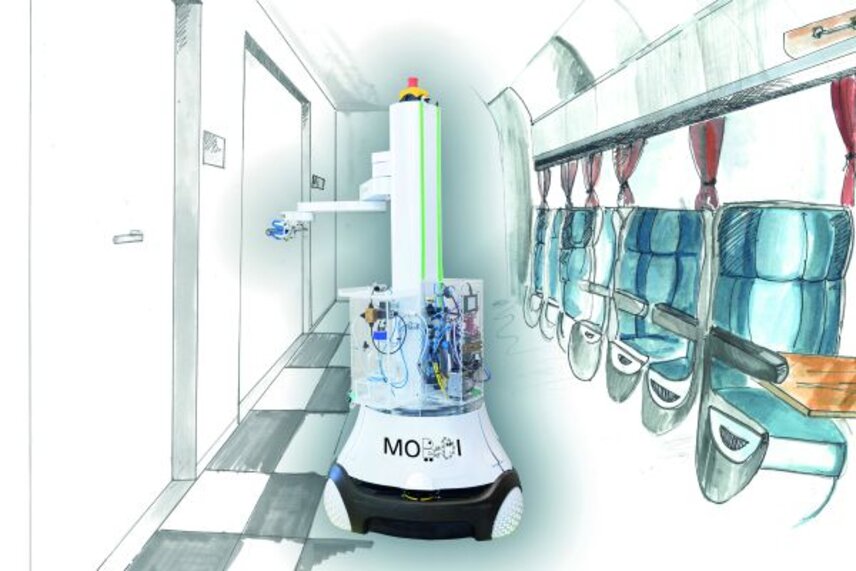
Service robots can help ensure that buildings and means of transport are cleaned and disinfected regularly and with consistently high quality. Since October 2020, twelve institutions of the Fraunhofer-Gesellschaft have been working on the development of new technologies for this field of application.
One key in the fight against COVID-19 is to minimize the risk of infection. This challenge is being addressed by the "Mobile Disinfection" (MobDi) project, in which the involved Fraunhofer experts are developing new hardware and software solutions for mobile service robots. On the one hand, these should make it possible to disinfect potentially contaminated surfaces in buildings and means of transportation as needed and gently with a robot. On the other hand, the developments should help to automate the transport of materials in clinics and thus counteract the spread of germs by staff.
The technical basis for disinfection in buildings is Fraunhofer IPA's "DeKonBot", which the institute developed last year in the previous project of the same name. The researchers will further improve its tool for wipe disinfection in the project and optimize the platform as a whole with regard to subsequent series production. The robot for disinfection in transportation vehicles is being developed at Fraunhofer IFAM. Particularly challenging is the development of a modular drive support for overcoming gaps and steps. For both robots, the project partners are creating various tools that disinfect by wiping, spraying, UV or plasma treatment. The robots can switch these automatically as required.
Fraunhofer IPA is also developing a new transport robot that can carry various hand carts, such as those typically used in clinics. Compared to existing products, the new development is characterized by small dimensions and a particularly maneuverable landing gear. The Fraunhofer IVV is providing support in the hygienic design of the various robots. The institute is also developing concepts for self-cleaning to prevent the machines themselves from becoming a contamination risk.
Thanks to intelligent perceptive capabilities, the disinfection robots will be able to clean in a targeted manner. A new multimodal 3D sensor from Fraunhofer IOF is used for this purpose. With the help of this sensor, the robots independently recognize all the objects they are to disinfect and the material they are made of during commissioning. The object recognition system of Fraunhofer IPA and the material recognition system of Fraunhofer IPM evaluate the sensor data using machine learning methods. A multilayer environment model developed by Fraunhofer IOSB brings together all the necessary information and thus enables the robots to plan cleaning sequences independently.
For targeted and gentle cleaning, the project partners are conducting tests with the various cleaning and disinfection processes on widely used surface types such as stainless steel and plastics. For example, the robots could first wipe a door handle and then use UV light to neutralize germs. For the various processes, researchers evaluate the disinfection success on the basis of contamination with both bacterial and also viral samples.
The technical developments in »MobDi« are based on requirement, benefit and economic analyses for which the Fraunhofer IMW is responsible. By the end of the project in September 2021, the developed robots will also be evaluated in a practical setting. The project partners will first test them in their respective laboratories and then in realistic operating environments such as in a public building, in passenger transport or in a clinic.
Contact: Dr. Birgit Graf, Fraunhofer FEP
birgit.graf@ipa.fraunhofer.de
DNA is not only the basic medium for storing genomic information, but can also be used to store binary data. …
The microtechnology industry has managed the Corona crisis quite well and is currently focusing intensively on sustainability. The industry is …
As part of the Fraunhofer project "BioIntElekt" metals should be mobilized with the help of bacteria. At the Fraunhofer FEP, …